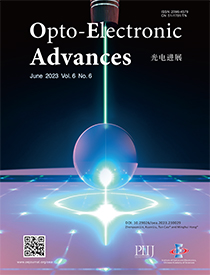2023 Vol. 6, No. 6
Cover story: Lin ZY, Liu K, Cao T, Hong MH. Hong MH. Microsphere femtosecond laser sub-50 nm structuring in far field via non-linear absorption. Opto-Electron Adv 6, 230029 (2023).
Using a dielectric microsphere as a near-field lens for super-resolution nano- imaging and nano-fabrication has attracted great research interest. However, the contact working mode of microsphere laser processing limits its further application. By lifting the microsphere to form a gap between the sample and the microsphere, the working distance can be increased to several micrometers, which leads to the microsphere working in far field. Recently, the research group of Prof. Minghui Hong from Xiamen University and the National University of Singapore, and Prof. Tun Cao from Dalian University of Technology jointly reported an ultrafast laser processing technology based on non-contact microspheres, realizing <50 nm functional nano-patternings on the surface of phase change materials. In non- contact mode, the microsphere is placed on a specially designed holder, and the nano-structures can be obtained by flexibly controlling of microsphere in x-y-z scanning. In this case, the distance between the microsphere and the sample is in the order of microns. Via the femtosecond laser irradiation of microsphere, this new technology enables the high speed machining of finer feature nano-structures in non-contact mode in various conditions. It also provides a new idea for ultrafine laser surface nano-machining, and its machining efficiency and machining freedom are expected to be further optimized and improved via microsphere array and microsphere engineering.
Back cover: Xing Y, Lin XY, Zhang LB, Xia YP, Zhang HL et al. Integral imaging-based tabletop light field 3D display with large viewing angle. Opto- Electron Adv 6, 220178 (2023).
Tabletop light field 3D display provides a brand-new display form that satisfies multi-user shared viewing and collaborative work, which is poised to become a potential alternative to traditional display forms. Recently, Professor Qiong-Hua Wang’s team at the School of Instrumentation and Optoelectronic Engineering of Beihang University and the College of Electronics and Information Engineering of Sichuan University has reported a large viewing angle tabletop light field 3D display based on integral imaging. This display achieved a breakthrough in radial viewing angle with 68.7° in a large display size of 43.5 inches, while maintaining high 3D image definition. The key component of the tabletop light field 3D display is a compound lens array made up of multiple three-piece compound lenses, which greatly extends the radial viewing angle in a limited amount of spatial information, while balancing other important 3D display parameters. This proposed display scheme is not only beneficial for tabletop display forms, but also provides optimization ideas for the other display forms. This research opens up the possibility of redefining the display forms of consumer electronics in the future.

-
{{article.year}}, {{article.volume}}({{article.issue}}): {{article.fpage | processPage:article.lpage:6}}. doi: {{article.doi}}{{article.articleStateNameEn}}, Published online {{article.preferredDate | date:'dd MMMM yyyy'}}, doi: {{article.doi}}{{article.articleStateNameEn}}, Accepted Date {{article.acceptedDate | date:'dd MMMM yyyy'}}CSTR: {{article.cstr}}
-
{{article.year}}, {{article.volume}}({{article.issue}}): {{article.fpage | processPage:article.lpage:6}}. doi: {{article.doi}}{{article.articleStateNameEn}}, Published online {{article.preferredDate | date:'dd MMMM yyyy'}}, doi: {{article.doi}}{{article.articleStateNameEn}}, Accepted Date {{article.acceptedDate | date:'dd MMMM yyyy'}}CSTR: {{article.cstr}}

 E-mail Alert
E-mail Alert RSS
RSS



